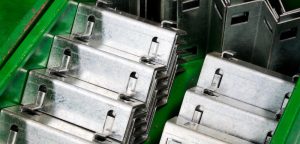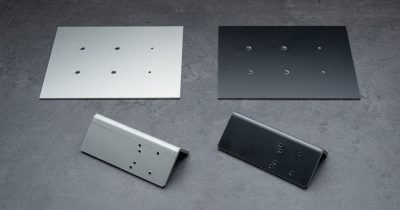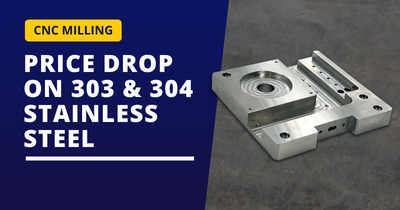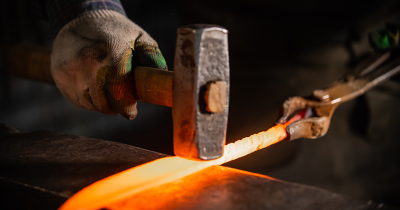303 vs. 304 Stainless Steel
—Understanding the Materials and Differences

There are many types of stainless steel, including grades 303 and 304. To select the appropriate material, it is necessary to comprehensively consider the purpose of the part, function, price, etc.
Table of Contents
303 stainless steel, also known as SS grade 303, SUS 303 in Japan, or EN 1.4305 equiv. in the UK, offers improved machinability compared to 304 stainless steel, which is the most widely distributed type of stainless steel (grade 304, SUS 304, or EN 1.4301 equivalent). Therefore, 303 is suitable as a material for milling. However, grade 303 has lower corrosion resistance and weldability than grade 304, so it may not be usable depending on the purpose or location.
In this article, we will explain in detail the basics of stainless steel and the differences between grades 303 and 304.
Basic Knowledge of Stainless Steel
- Stainless steel, as its name implies, is a corrosion-resistant alloy steel. Generally, “stainless steel” refers to steel that is primarily composed of iron and contains at least 10.5% chromium. There are many types of stainless steel, each with unique properties. These grades are identified by three-digit numbers, such as 303 and 304. For example, the 300 series is classified as austenitic stainless steel, while the 400 series includes ferritic and martensitic stainless steels.

What is 303 Stainless Steel?
303 stainless steel, an austenitic stainless steel, is produced by adding sulfur and phosphorus to grade 304. The addition of these elements decreases stickiness, making grade 303 outstanding in terms of machinability and cutting performance. It also demonstrates good resistance to galling, with minimal adhesion due to friction. While inherently non-magnetic, changes in crystal structure during processing can cause grade 303 to exhibit magnetic properties.
What is 304 Stainless Steel?
304 stainless steel is a widely used variant known for its excellent corrosion resistance and versatility. It consists of 18% chromium and 8% nickel, creating a robust alloy that demonstrates remarkable durability and resistance to oxidation. The chromium content enables the formation of a passive oxide layer on the surface, which prevents corrosion and enhances longevity. With its non-magnetic characteristics, grade 304 is extensively used in various industries, including kitchenware, architectural structures, and the manufacturing of industrial equipment. Its mechanical properties, such as tensile strength and toughness, make grade 304 a preferred choice for applications that demand both strength and corrosion resistance. This alloy is particularly valuable in environments where exposure to corrosive elements is a concern.
Differences Between 303 Stainless Steel and 304 Stainless Steel
Understanding the differences between grade 303 and 304 is essential for selecting the right material for specific applications.
304 stainless steel is the most commonly distributed representative stainless steel. Stainless steel components found in hardware stores and similar outlets are mostly made of grade 304. While the basic material properties of grade 303 and grade 304 are similar, there are notable differences between the two, including:
- Corrosion resistance: The sulfur and phosphorus in 303 stainless steel react with oxygen in the air, resulting in lower corrosion resistance compared to grade 304. In environments prone to corrosion, 304 is the better choice over 303.
- Weldability: Phosphorus and sulfur added to grade 303 tend to segregate (distribute unevenly) within the alloy, leading to an increased likelihood of shrinkage stress. This makes welding 303 more prone to cracking. If welding is necessary, grade 304 is recommended over grade 303.
- Machinability: The higher sulfur and phosphorus content in grade 303 reduces stickiness, enhancing machinability. Therefore, grade 303 has superior machinability compared to grade 304.
- Price: 303 stainless steel tends to be slightly more expensive than grade 304.
How to Distinguish
303 and 304 stainless steel are very similar in appearance, making it hard to visually differentiate between them. One effective method is to compare the chips generated during cutting. Generally, chips from materials with high stickiness like grade 304 are connected in a continuous strand. In contrast, chips from grade 303, where sulfur and phosphorus are added to reduce stickiness, are finer and more scattered. Another method involves welding both materials and observing which welds more successfully, revealing grade 304.
Applications of 303 Stainless Steel and 304 Stainless Steel
303 Stainless Steel
303 stainless steel is commonly used in industrial products such as bolts, nuts, and shafts. It is also used in machine components. The material is often available in the form of round bars and is processed into various shapes.
304 Stainless Steel
Due to its superior corrosion resistance compared to 303 stainless steel, 304 stainless steel is used in the outer panels of trains. It is also utilized in areas where the silver color of the material is highlighted, such as automatic doors, escalators, pillars, and handrails. Grade 304 is used in a wide range of applications, including industrial products such as nuts and bolts, plant equipment such as LNG tanks and nuclear facilities, and in medical, pharmaceutical, and food manufacturing equipment.
Conclusion
Stainless steel, classified in the 300 series as austenitic stainless steel, is an alloy steel with added chromium to resist corrosion. Grade 303 excels in machinability and anti-seizure properties compared to grade 304, but falls short in corrosion resistance and weldability. Both 303 and 304 materials are available in various shapes for CNC Milling ,CNC Turning ,and Sheet Metal at meviy.
What’s meviy?
On-demand, fast sourcing of quality custom mechanical parts is made possible by meviy.
meviy is one of the most reliable on-demand manufacturing platforms in the US that allows you to get instant quotes for your mechanical parts simply by uploading 3D CAD data. No longer need to create 2D drawings just to quote parts. This platform supports sheet metal fabrication and CNC machining such as milling or turning and has saved time for over 160,000 mechanical designers and purchasers worldwide.






